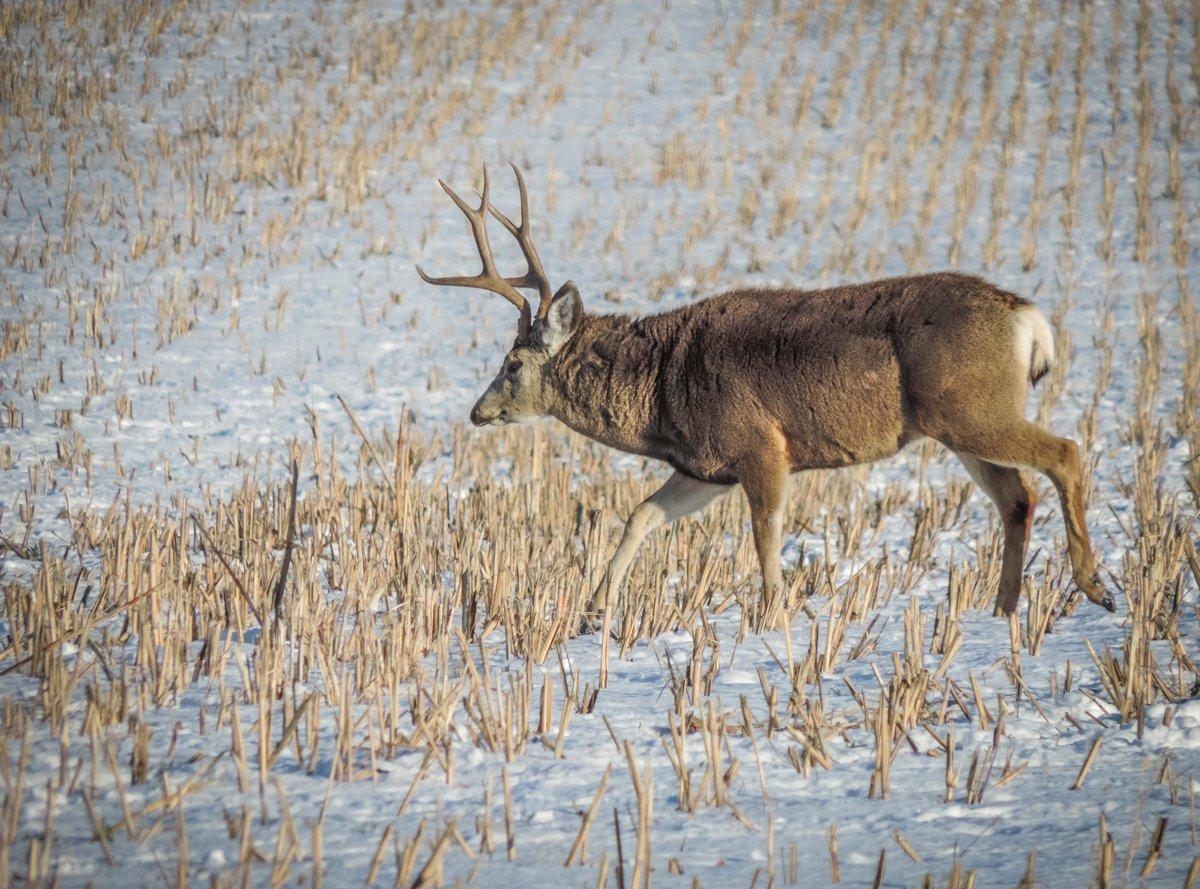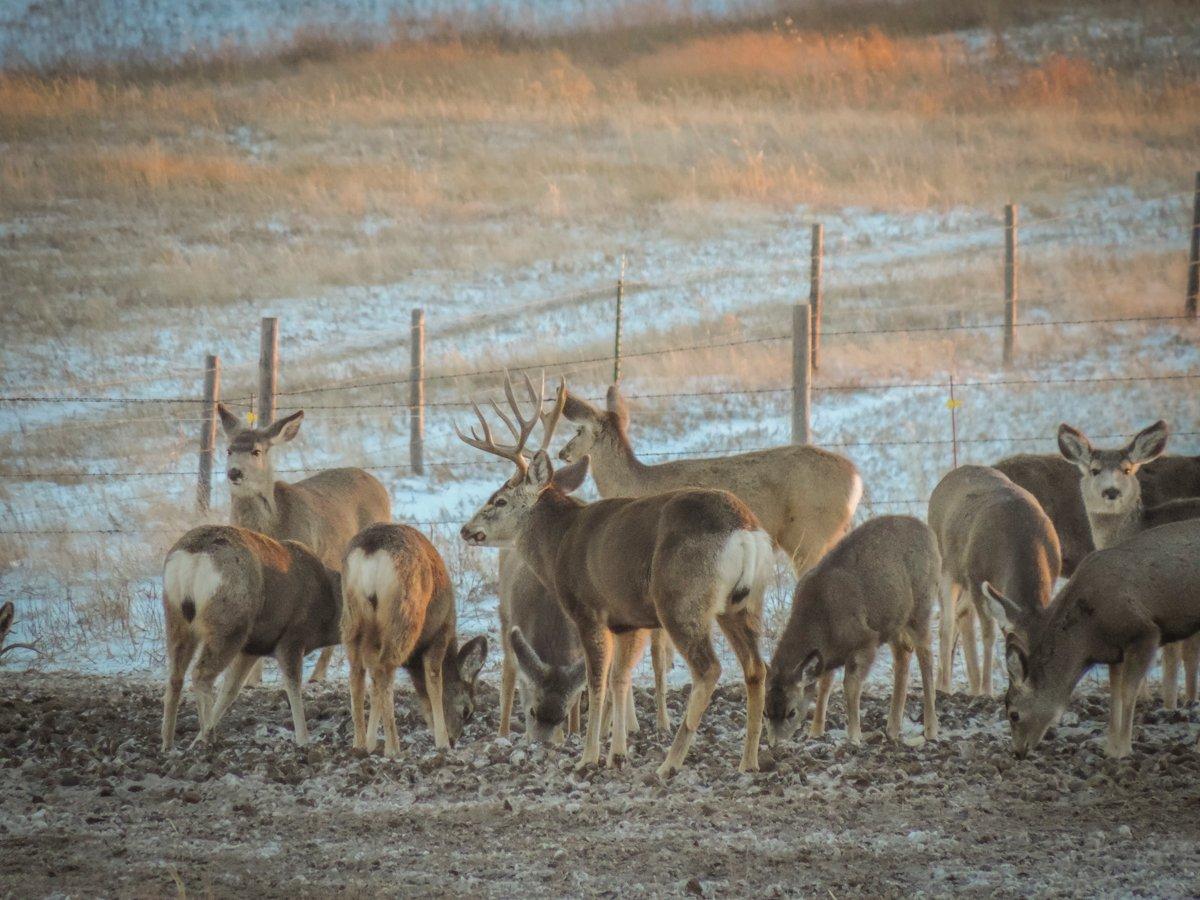Mature muley bucks act like whitetails in many ways, but there are key differences between them hunters should know
Mule deer are a somewhat peculiar deer species. These western icons have a few tendencies that resemble those of whitetails, but with some distinct behavioral differences worth noting, too. Muleys are incredibly fun to hunt, and I've had the pleasure of chasing them many times in a few different states over the last 15 years. Here are some of the tendencies in mature bucks that I've observed along the way.
1. They Bachelor up in Summer
Much like whitetails, muley bucks typically spend the summer months in bachelor groups of two to six animals, sometimes more. Often, they're very visible — especially at first and last light — on lush hillsides and in crop fields. In habitat with lots of standing corn, finding them can be a bit more difficult, as they often bed right in the stalks and come out only to water. Of course, harvest time wipes out much of their cover, making them easier to find.
Similarly, high-country muley bucks also spend the summer months in bachelor groups. During this window, they're more predictable than they will be for the remainder of the year, although they're rarely as predictable as bachelor white-tailed bucks. Once they shed their velvet, they generally disperse just like whitetails do. However, these high-elevation monarchs habitually migrate downslope to lower elevations at the first onslaught frigid temperatures and snow accumulation.
You'll often find bachelor bucks in the same general vicinity for days at a time until they're disturbed or strip their velvet. In most states, archery seasons open right before or during the window when bucks begin rubbing off their velvet. This gives bowhunters a narrow opportunity to exploit the visibility of bachelor bucks before they split up and become less predictable. Remember, though, that all of the eyes, ears and noses can make stalking within archery range difficult.
Don't Miss: Are Mule Deer Getting the Boot from Whitetails?
2. They Bust up and Get Reclusive
Shortly after the bachelor pad splits and bucks head their separate ways, it often becomes tough to relocate the largest animals. As in summer, they're on their feet early and late, but now they're often confined to more secluded haunts. Don't be fooled, though, as this can be a great time to stalk a buck since there will be fewer eyes and ears to contend with.
Bowhunters looking to find mature bucks during their solo days can map out roadless pockets with grazing and water, and often a big buck can be found. Lots of glassing with a quality binocular is the key. Study brushy thickets and watch for the glimmer of an antler tine or the flicker of an ear or tail.
3. They Guard Doe Harems During the Rut
Late October gets muley bucks in the mood to breed, and they begin covering ground to look for does. On the prairies where I've done most of my mule deer hunting and throughout most other habitats within the mule deer's range, peak breeding occurs between mid-November and into the beginning of December.
Mule deer bucks can start rutting as early as late October through the first week or so of December, with the peak across the range occurring around the third week of November, said Miles Moretti, president and CEO of the Mule Deer Foundation. The rut depends on weather, length of day and, of course, when the does come into estrous.
Boss bucks typically find and guard small to large harems of does as the rut winds up.
Moretti said, Does tend to group together on their own. Bucks search out does but don't necessarily have personal harems. Most mule deer bucks will travel long distances breeding as many does in the area as they can. Sometimes, they're interrupted by fighting with another buck for dominance.
When conditions are calm, these harems usually occupy wide-open spaces during broad daylight. The openness is a blessing and curse. It makes deer easy to find but challenging to approach. When a big dominant buck carouses amongst a doe harem, nudging them about and keeping them in line, other subordinate bucks usually look for an easy in.
As does within the harem reach estrus, I've witnessed the dominant buck singling them out to breed, while subordinate bucks continue circling like vultures. It takes great authority for the boss to fend them off. Generally, the breeder buck will bed right next to the hot doe, similar to a whitetail buck in lockdown. I've witnessed this numerous times.
As a bowhunter, this is one of my favorite situations. Bucks become quite complacent right before, during and after breeding, and that allows for aggressive moves. You might consider approaching with a buck decoy (more on that in a bit) or just sneaking right into the mix. I once charged into a group of deer looming amidst a patch of cedars. I could hear the dominant buck grunting, and while a bedded fawn was looking right at me, I ignored it and aggressively ran ahead to the closest cedar and took a knee. The bewildered fawn didn't bolt or alarm the other deer, and the bruiser sauntered out from behind brush 25 yards away. I arrowed that old buck, which had teeth worn nearly to the gumline.
Don't Miss: The Top States for Record Mule Deer in the Last 10 Years
4. You Can Become a Satellite
Satellite bucks old and young will flank the harem, attempting to slink into the mix. Boss bucks don't stand for this. Some subordinate bucks get too big for their britches and try to fight the king, but they're seldom successful. Each time a subordinate buck approaches the harem guarded by a dominant buck, the old battler begins posturing and walking stiff-legged toward the invader. Most bucks cower and retreat, but sometimes a fight ensues. Most of the fights I've witnessed were gentle sparring matches, but scars, severe injuries, broken antlers and even death are possible.
Knowing this, approaching the harem from behind a buck decoy can be a productive ploy. Two-dimensional decoys like those from Montana Decoy and Heads-Up Decoy are solid options. The key is to keep the wind in your face, take your time and keep your profile as low as possible behind the decoy. Unless the does spook, your odds of getting within bow range are good. And when you get within 100 yards, it's probable that the buck will approach and challenge you. Be prepared to range, draw and shoot fluidly over or to the side of the decoy.
5. They Feed Heavily After the Rut
Once the primary breeding cycle subsides, I've witnessed bucks remain in large groups of deer and buckle down on food sources. Mature bucks worn from the rut's heydays are now more tolerant of younger bucks joining the herd. Because breeder bucks focus so intently on fighting and breeding during the pre-rut and rut, they feed very little. Now, their appetite takes priority. To withstand the winter ahead, they must eat as much as possible to survive the brutal winter months.
By this point, the deer have probably been hunted quite heavily. They can be difficult to stalk since they're now cagier than ever, but all it takes is a blast of snow to concentrate them to specific areas and travel routes where you can hunt them just like whitetails.
Just last December, I arrowed a beautiful buck from a treestand I'd hung over a patch of winter wheat that the sun had exposed following an early December blizzard. I was in the stand less than three hours before my opportunity came.
Don't Miss: 7 Tips for Over-the-Counter Mule Deer Hunting
Check out more stories, videos and educational how-to's on deer hunting.










